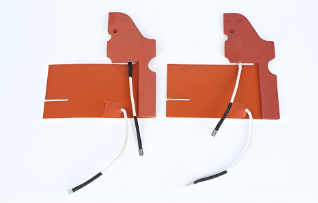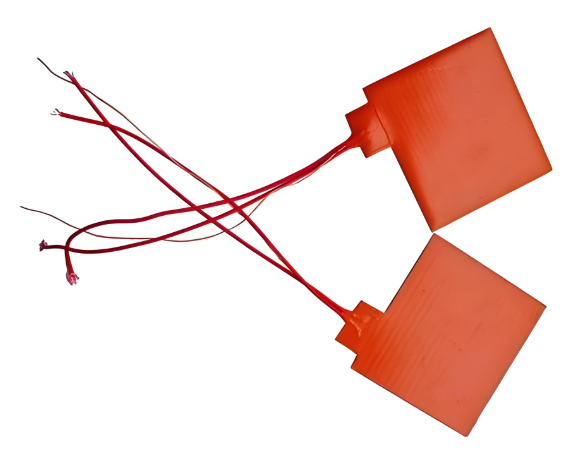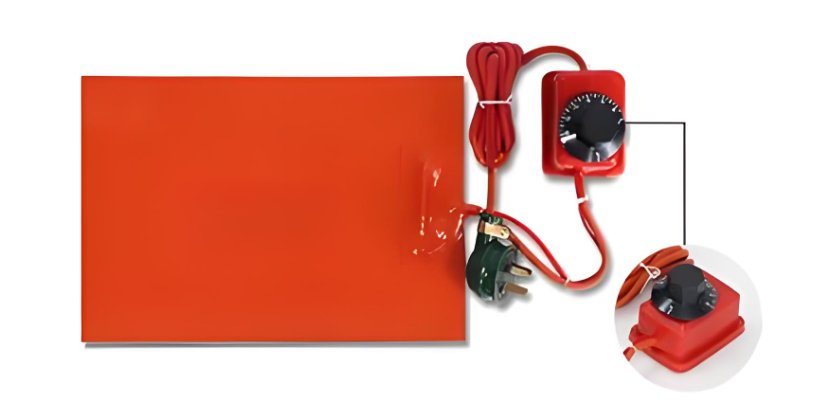When designing or choosing a silicone heater, thickness is one of the first factors to consider. It affects not only flexibility and heat transfer but also how well the heater fits into the final product.
A standard silicone heater has a specific structure. Besides the heating layer itself, there are areas like wire welding sections that are thicker because of insulation materials. Understanding these differences helps you design products with better accuracy and safety.
The standard thickness of a silicone heater is 1.5mm ±0.15mm.
This thickness offers an excellent balance between flexibility, durability, and heat distribution. It’s thin enough to conform to curved surfaces yet strong enough to withstand mechanical stress during installation or operation.
For applications requiring tighter spaces, custom thin designs can be made (for example, around 1.0mm). But for most industrial and commercial uses, 1.5mm remains the most stable and cost-effective choice.

A 1.5mm silicone heater can handle stable power output and maintain even temperature distribution across the surface. It provides sufficient insulation while keeping the heater lightweight and flexible.
Thicker heaters can store more heat but may respond slower to temperature changes. Thinner ones heat faster but offer less mechanical protection. The 1.5mm specification strikes the right balance for long-term reliability and consistent thermal performance.
At the wire welding position, the silicone layer is reinforced with extra silicone insulation, which increases total thickness.
The total thickness at the wire welding area is typically 4–5mm, and it should not exceed 5mm. This added thickness protects solder joints and wire connections from mechanical stress, moisture, and electrical leakage.
Even though it’s thicker, this area is carefully sealed to ensure smooth installation and safe operation. The transition between the main heater body and the welding point is gradual to prevent stress concentration or cracking.

The welding area carries electrical connections where wires meet the heating element. These spots must endure heat, vibration, and bending during use.
By adding extra silicone insulation layers, the manufacturer prevents short circuits and maintains stable performance over long periods. It also protects the internal structure from being exposed or damaged during assembly. The slight increase in thickness is a necessary trade-off for safety and durability.
Yes, silicone heater thickness can be customized based on application requirements. Some customers request ultra-thin heaters (around 0.8mm–1.0mm) for space-limited designs. Others prefer thicker versions (up to 2.5mm) for environments needing better insulation or mechanical support.
However, the welding area thickness typically remains between 4–5mm, even for custom designs, to guarantee proper insulation around soldered wires.
When requesting customization, it’s essential to share details like operating temperature, voltage, and mounting method so engineers can recommend the best thickness combination.
Silicone heater thickness is not random — it’s determined by several practical and technical considerations that balance performance, durability, and safety. Each factor influences how well the heater conducts heat, how it’s installed, and how long it lasts during operation. Let’s explore the main aspects that affect silicone heater thickness in detail.
1. Power Density and Wattage Requirements
The first and most critical factor is power density — the amount of power output per square centimeter. Higher watt densities require thicker heaters to handle the additional thermal stress. A thicker silicone layer helps distribute heat evenly and prevents hot spots.
For example, a 2 W/cm² heater generates far more heat than a 0.5 W/cm² one, so the insulation and silicone layer must be thicker to prevent overheating and electrical breakdown. In contrast, low-power heaters can use thinner silicone sheets for better flexibility.
2. Operating Temperature Range
The working temperature directly influences the silicone heater thickness. If the heater is designed for temperatures below 120°C, a 1.0–1.5 mm thick silicone sheet is usually sufficient.
However, for heaters that operate near 200°C or more, the thickness often increases to 2–2.5 mm to provide adequate insulation and mechanical strength.
3. Mechanical Strength and Durability
In applications where the heater will experience bending, compression, or vibration, a thicker silicone layer offers greater mechanical strength.
Industries such as automotive, aerospace, and industrial manufacturing often require thicker heaters to endure physical stress and ensure a long lifespan. On the other hand, in flexible or portable devices where space is limited, engineers usually select thinner heaters for better compliance and easier mounting.
4. Installation Surface and Mounting Method
The surface where the silicone heater will be attached also affects its thickness.
When installed on flat, rigid surfaces, thinner heaters can be used because the heat transfer is efficient and even.
If the mounting surface is curved or uneven, thicker heaters are preferred to maintain close contact and uniform heat distribution. Additionally, adhesive backing (such as 3M 467 or 468) or mechanical clamps can slightly increase the overall thickness.
5. Electrical Insulation and Safety Requirements
Electrical safety standards often dictate the minimum insulation thickness for silicone heaters. For high-voltage applications (for instance, above 220V), a thicker silicone layer is necessary to prevent electrical leakage and ensure safe operation.
The silicone rubber acts as both a thermal conductor and an insulator, so the right balance is essential. Insufficient thickness could lead to potential breakdowns or safety hazards, especially in humid environments.
6. Size and Shape of the Heater
Larger silicone heaters often need greater structural support to maintain shape and stability during use, especially when attached to metal plates or complex surfaces.
Therefore, they typically feature slightly thicker silicone layers compared to smaller heaters. The additional thickness also helps distribute pressure evenly across a large area and prevents tearing during installation.
A client from the semiconductor equipment industry needed a compact silicone heater that could maintain stable heating at 180°C. The team at Danyu Electronics recommended a 1.5mm standard thickness heater with reinforced wire soldering points measuring 4.5mm.
The final design achieved uniform heating without exceeding the space limit. The thicker insulation at the welding area provided excellent protection against mechanical pull during assembly.

Danyu Electronics specializes in the design and manufacturing of custom silicone heaters with precise control over thickness and structure.
We follow strict quality standards, including ISO9001, ISO13485, IATF16949, and AS9100D, covering applications from medical to aerospace industries. Our production process uses MES systems to track every step, ensuring full material traceability.
From selecting the silicone compound to designing wire joints, our engineers carefully test each heater for insulation resistance, dimensional accuracy, and heat performance.
If you’re looking for a trusted silicone rubber heater manufacturer, Danyu Electronics offers expert engineering support, stable quality, and on-time delivery to help your projects move faster.
1. What is the standard thickness of a silicone heater?
The standard thickness is 1.5mm ±0.15mm.
2. Why is the wire connection area thicker?
Extra silicone insulation is added to protect the solder joint, increasing total thickness to about 4–5mm.
3. Can I order a thinner or thicker silicone heater?
Yes. Danyu Electronics offers custom thickness options from 0.8mm to 2.5mm depending on your needs.
4. What happens if the welding area is too thick?
If it exceeds 5mm, it may affect mounting or flexibility, so strict control is maintained during production.
5. How does Danyu Electronics ensure quality consistency?
Each heater is fully traceable through our MES system and tested under ISO-certified standards.
Simply drop your email or phone number in the contact form, and we'll promptly reply you shortly.